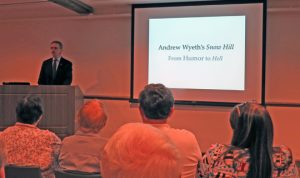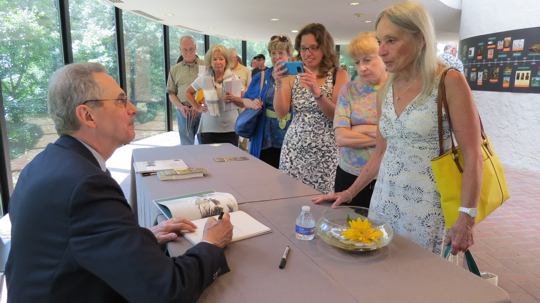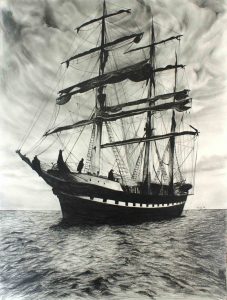
Bernie and Jim Garrison of Phoenixville came prepared to immerse themselves in the life and art of Andrew Wyeth at the Brandywine River Museum of Art last Saturday. They sat in the lecture room, each holding a book in their laps, waiting for James (Jim) H. Duff, Executive Director Emeritus of the Brandywine Conservancy & Museum of Art, to begin his talk. Duff was to speak on his newly published book, which shares the name of Wyeth’s iconic painting, Snow Hill.
Bernie looked through her copy of Duff’s book. Jim read from the exhibition catalog for Andrew Wyeth: In Retrospect, the museum’s current exhibition, which celebrates the centennial of Wyeth's birth. Like so many local residents, the Garrisons had their own personal connection to Wyeth to share. Jim Garrison was the architect on the renovations for the Wyeth studio before it opened to the public.

If you know Jim Duff at all, you chuckled at his lecture title, Snow Hill: From Humor to Hell, and expected his sharp wit to be on display. Not so much. Instead, Duff quickly explained that Hell was the name of a painting that may have influenced Wyeth as he composed his picture. Duff then proceeded to “school” the audience on multiple aspects of Snow Hill, from the artists and paintings that influenced the work and give insights into his friend of more than thirty years.
The first thing Duff pointed out was the large size of the painting. It measures 4 x 6 feet. The expansiveness of the scene was critical in conveying the feeling of the painting. Wyeth refused to let small reproductions be printed or for an image of Snow Hill to be included in books. As a result, art historians did not include mention of the painting in their essays and the painting is not as well-known as other Wyeth works. And, it rarely left the museum. “You had to come here to see it,” Duff explained.
Wyeth completed Snow Hill in 1989, when he was 71 years old. The tempera on hardboard panel was so personal to him. He rarely discussed it. In the forward of Duff’s book, Tom Padon, Director of the Brandywine River Museum of Art, wrote, “In this haunting composition, Wyeth gave a visual and poetic summary of Chadds Ford, Pennsylvania, residents whom he had known well and who had given him artistic inspiration at key points in his career.”
Wyeth’s favorite models are all present wearing the same outfits they wear in other well-known Wyeth works. Karl Kuerner appears in his WWI German Army uniform, Anna Kuerner has donned her apron and cap, William Loper has his distinctive hook, Helga Testorf wears her familiar braids and loden coat, Allan Lynch sports the same hat, boots and jacket from Winter 1946 and Adam Johnson, is garbed in his characteristic denim coat.
The models are dancing around a May pole in the snow. Wyeth, in his impish way, once shared, “The subjects are celebrating because I am dead and they will no longer have to sit for me!” This was not a plein air painting—he painted it in his studio over the course of two years—yet, it captures the exhilaration of being alive on top of a hill enjoying the clean, crisp air. He succeeds in his intent to express a feeling of “absolute joy.”
The dancers are holding ribbons of different colors: Helga’s is white (Wyeth’s favorite color) and another white ribbon is floating in the wind with no one holding on to it. Is that free-floating white ribbon intended for Wyeth himself—there, but not there?
Wyeth manipulated Kuerner’s Hill and the area around it for Snow Hill. He removed trees and houses, thereby adding to the magic of the painting. We can’t see any of the subjects’ faces. The dancers are not in “step” except for their joy. Is Kuerner Hill a metaphor for the chest of Andrew’s beloved father, N.C. Wyeth, still rising and falling with breath? Wyeth himself once said, “You decide what it’s about.” Duff concluded in his lecture, “Much of this painting will remain mystifying. And Andrew Wyeth would have wanted it that way.”

Waiting in line for the book signing that followed, Kathy Meaney held her copy of Snow Hill open to the page that displays the house she used to live in on Ring Road. “Wyeth frequently sketched on the property; he loved our unusual chimney,” she remembered.
To understand Snow Hill in some small way is to understand Andrew Wyeth in some small way. Duff’s lecture offered more insights into Snow Hill and Wyeth’s art than space here permits. To learn more about Snow Hill and the artist, you will have to, as they say, “Read the book.” Copies of Andrew Wyeth: Snow Hill ($39.99), published by the Brandywine River Museum of Art and Skira Rizzoli of New York, are available in the Brandywine River Museum of Art Shop.
About Lora B. Englehart
Lora has a passion for art, gardening, yoga, music and dancing. She continues to research the life of locally born abolitionist and 1998 National Women's Hall of Fame inductee Mary Ann Shadd Cary. She is a dedicated community volunteer, working with the American Association of University Women, Wilmington, DE branch (programs chair), Chadds Ford Historical Society (former board member) and Brandywine Conservancy & Museum of Art. Lora lives in Birmingham Township with her husband Bill and son Brad. Daughter Erika lives in Pittsburgh with husband Bob and baby Wilhelmina. She is a former French, Spanish and ESL teacher, bilingual life insurance underwriter and public relations coordinator for Delaware Art Museum and Brandywine Conservancy & Museum of Art.



Comments